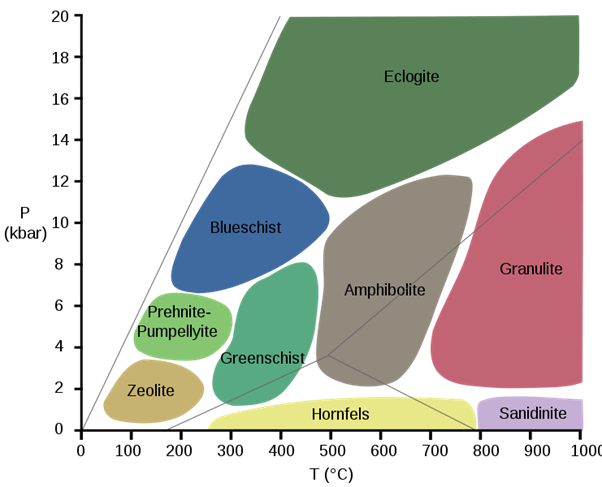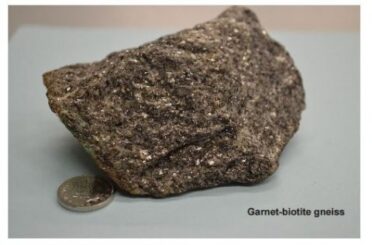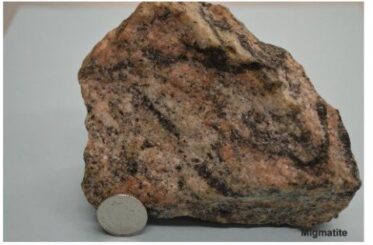Metamorphic Rocks
Introduction
Metamorphic rocks are formed through the transformation of pre-existing rocks in a process known as metamorphism (meaning “change in form”). The original rock, or protolith, is subjected to heat and pressure which cause physical, chemical and mineralogical changes to the rock. Protoliths may be igneous, sedimentary or pre-existing metamorphic rocks.
Metamorphic rocks are formed within the Earth’s crust. Changing temperature and pressure conditions may result in changes to the mineral assemblage of the protolith. Metamorphic rocks are eventually exposed at the surface by uplift and erosion of the overlying rock.
There are two main types of metamorphism: regional metamorphism and contact, or thermal, metamorphism. Metamorphic rocks are categorised by texture and mineralogy. Specific zones of temperature and pressure define different metamorphic facies. Rocks containing minerals diagnostic of each facies can be linked to the temperature and pressure that characterise that facies. For example, blueschist and eclogite facies rocks form under low to medium temperatures and high pressures. Such conditions as usually associated with subduction zones. Hornfels facies rocks typically occur under the medium to high temperature and low pressure conditions associated with contact aureoles.
Each metamorphic facies is associated with a group of index minerals from which it can be identified. The exact set of indicator minerals from each group that is present in a particular instance depends on the chemical composition of the protolith. Information about the mineralogy of each metamorphic facies may be found in Grotzinger and Jordan.

Metamorphic facies. Greenschist, amphibolite and granulite conditions are typically associated with regional metamorphism. Blueschist and eclogite are associated with the type of regional metamorphism that occurs at subduction zones. Hornfels and sanidinite are typically associated with contact metamorphism. (Image from Wikipedia Commons.)
Regional Metamorphism
Regional metamorphism usually results in the formation of rocks that are strongly foliated, such as slates, schists, and gneisses (see below). The differential stress needed to produce such foliated rocks usually results from tectonic forces that produce compressional stresses in the rocks such as occur when two continental masses collide. Thus, regionally metamorphosed rocks are found in the cores of fold/thrust mountain belts or in eroded mountain ranges. Compressive stresses result in folding of rock and thickening of the crust, which results in some of the rocks being pushed to deeper levels where they are subjected to higher temperatures and pressures.
The pressure and heat which drive metamorphism come from three sources: the internal heat of the Earth; the weight of the overlying rock; and the horizontal pressures developed as rocks become deformed.
Temperature within the crust increases with increasing depth from the surface by 20 to 60°C per kilometre of depth; 30°C per km is considered to be the average. For example, at a depth of 15km the temperature will be about 450°C. The pressure at 15km depth is derived from the weight of the overlying rock, and is about 4000 times the pressure at the Earth’s surface.

Grades of metamorphic rock. A metamorphic rock which has experienced a temperature of 600°C and a pressure of 600MPa is termed a “high-grade metamorphic rock”. (Image from Tulane. edu.)
Metamorphic rocks formed in the shallow crust are referred to as low-grade metamorphic rocks; those at higher temperatures and pressures as high-grade metamorphic rocks. Through uplift and erosion, these rocks are eventually exposed at the Earth’s surface.
Contact Metamorphism
Contact metamorphism typically occurs around intrusive igneous rocks, and is the result of temperature increase associated with the introduction of hot magma into the colder country rocks. The area surrounding an intrusion, where metamorphism is present, is called a metamorphic aureole. Metamorphism is greatest closest to the intrusion and dissipates as distance from the intrusion increases. The size of the aureole depends on the temperature of the igneous intrusion, the size of the intrusion and the temperature of the country rock. Dykes may have a small band of adjacent rock which has been locally metamorphosed, but the effects of this metamorphism are usually minimal. Large intrusions, such as granite batholiths, may have metamorphic aureoles covering a significant area. Where the country rocks are pelitic in composition (i.e. they are formed from small silt particles), the rock closest to the intrusion is “baked”, forming a hard, splintery type of rock referred to as a hornfels. Hornfels may have a spotted appearance due to the growth of minerals such as cordierite and andalusite. In rocks of different compositions other minerals will form. For example olivine may form in an impure limestone.
The metamorphic grade of an aureole zone is quantified by which minerals occur within that zone. Shale closest to an intrusion may be altered to hornfels and contain minerals such as sillimanite or cordierite. Further from the intrusion, the same shale may seem reasonably unaltered apart from the development of some crystals of andalusite.

Contact metamorphism and associated minerals for different types of country rock. Aluminium-rich shale will form indicator minerals such as cordierite and sillimanite. Impure limestone may host indicator minerals such as olivine. Where there are significant volumes of fluid present, skarns may form. (Image: Wolf 2010.)
Metamorphic Minerals
All rocks are composed of minerals, and each mineral is only stable over a particular range of temperatures and pressures. Outwith that range it will tend to break down or combine with a neighbouring mineral to form a new mineral.
The process of metamorphism is associated with the formation of particular metamorphic minerals. Some silicate minerals are so diagnostic of metamorphism that their presence indicates that the rock is metamorphic. These mineral are known as index minerals and include andalusite, kyanite, staurolite and sillimanite. Some other minerals, such as garnet, muscovite, feldspar, quartz and micas, are also present in metamorphic rocks, but these may also be found in igneous and sedimentary rocks.
Metamorphic zones
The concept of metamorphic zones can be illustrated by considering what happens to mudrock as it becomes subjected to increasing levels of metamorphism. Mudrock is a fine-grained sedimentary rock which often contains aluminium-rich minerals, and it produces the following minerals as it is progressively metamorphosed, from a low-grade to a high-grade rock:
- Chlorite zone: quartz, chlorite, muscovite, albite
- Biotite zone: quartz, muscovite, biotite, chlorite, albite
- Garnet zone: quartz, muscovite, biotite, garnet, Na plagioclase
- Staurolite zone: quartz, muscovite, biotite, garnet, staurolite, plagioclase
- Kyanite zone: quartz, muscovite, biotite, garnet, kyanite, plagioclase, +/- staurolite
- Sillimanite zone: quartz, muscovite, biotite, garnet, sillimanite, plagioclase
In extreme conditions, metamorphic rocks can become partially melted. When the partially melted rock cools, it is composed of light bands consisting of igneous components and dark bands of unmelted metamorphic material. Such rocks are called migmatites.
Metamorphic textures
Just as a metamorphic rock can be defined by its mineral assemblage, it can also be defined by its texture. This may be a more useful method of categorizing metamorphic rocks when in the field. The term “texture” describes the size, shape and arrangement of grains within a rock. During regional metamorphism, pressure causes crystals to align until they are at right angles to the direction of maximum compression. This occurs through the gradual rotation of existing crystals and the growth of new crystals in a pressure-controlled orientation. Alignment of minerals into planes is called foliation. As a general rule, the coarser the grain size of the rock (excluding porphyroblasts – see below), the higher its metamorphic grade. For example, it may be impossible to identify individual minerals in a slate with a hand lens; in schist it may be possible to differentiate minerals even with the naked eye, and certainly with a hand lens.
Foliated textures
Slaty cleavage – closely spaced planar surfaces along which rocks are easily split; seen in slate, which is a very fine-grained foliated rock derived from an original shale protolith.
Schistosity – medium sized platy minerals in a preferred orientation, often interlayered with quartz and feldspar; characteristic of the rock type schist.
Gneissic texture – seen in high-grade metamorphic rocks and characterised by medium- to coarse- grained crystals arranged in alternating bands of dark and light minerals (gneissic banding)
Non-foliated textures
Granoblastic – a mosaic of equidimensional grains; hornfels, marble and quartzite have a granoblastic texture.
Porphyroblastic – characterised by porphyroblasts, which are large crystals surrounded by a finer-grained groundmass in a metamorphic rock. This texture is often seen in garnet-mica schists.
metamorphic grade between slate and schist.)
Further reading
Grotzinger J.P. & Jordan, T.H. (2014) Understanding Earth, 7th edn, Chapter 6. Freeman.
Rothery D.A. (2003) Teach Yourself Geology. Teach Yourself Books.
Emma Fairley



